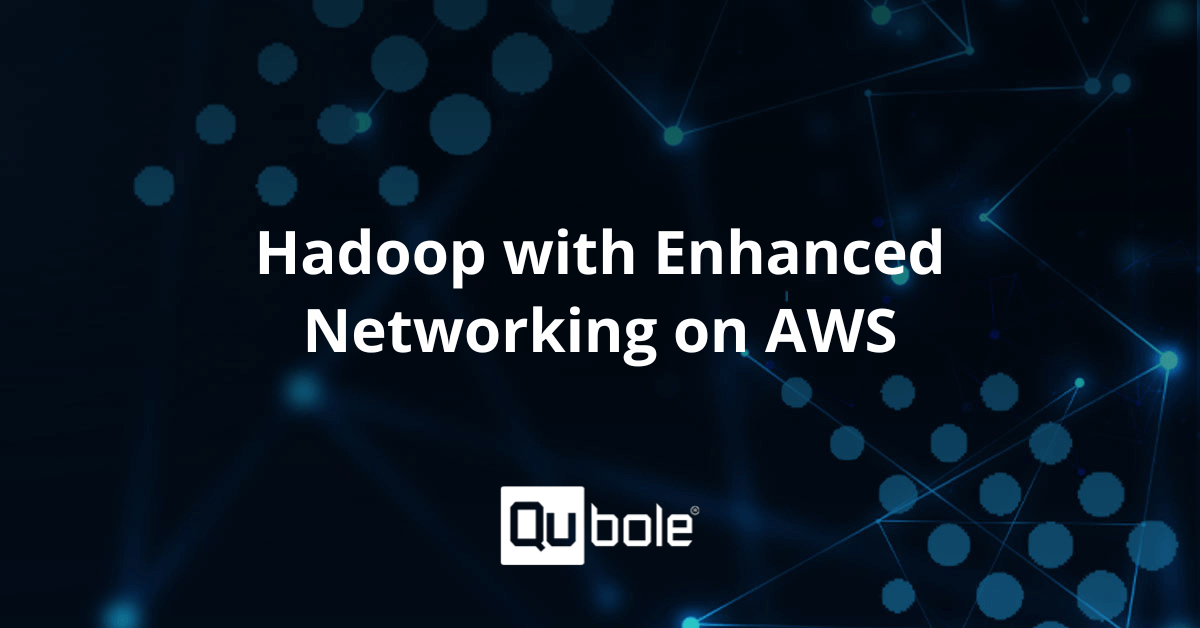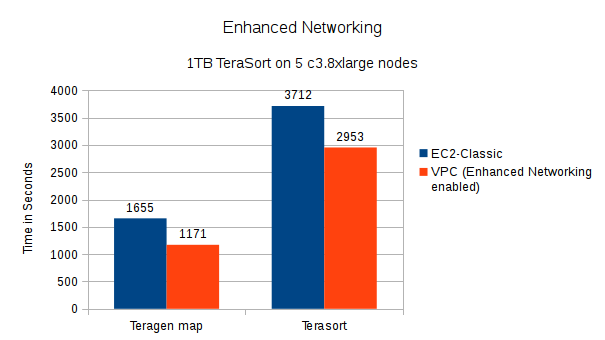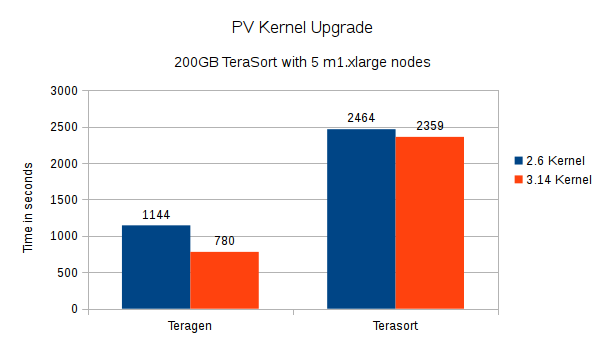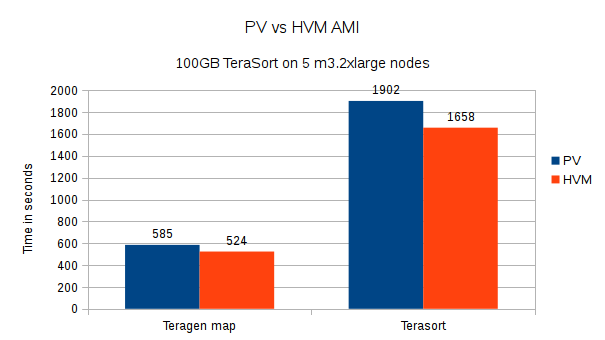Hadoop with Enhanced Networking on AWS
Introduction At Qubole, many of our customers run their Hadoop clusters on AWS EC2 instances. Each of these instances is a Linux guest on a… The post Hadoop with Enhanced Networking on AWS appeared first on Qubole.

Introduction
At Qubole, many of our customers run their Hadoop clusters on AWS EC2 instances. Each of these instances is a Linux guest on a Xen hypervisor. Traditionally each guest’s network traffic goes through the hypervisor, which adds a little bit of overhead to the bandwidth. EC2 now supports Single Root I/O Virtualization (called Enhanced Networking in AWS terminology) on some of the new instance types, wherein each physical ethernet NIC virtualizes itself as multiple independent PCIe Ethernet NICs, each of which can be assigned to a Xen guest.
Many resources on the web (such as this) have documented improvements in bandwidth and latency when using enhanced networking. This was mentioned by our helpful partner engineers at AWS as another one of the low-hanging fruits that we should investigate. Hadoop is very network I/O intensive – large amounts of data are transferred between nodes as well as between S3 and the nodes – hence it stands to reason that Hadoop workloads would benefit from this change. However – as someone once said, following recommendations based on someone else’s benchmarks is like taking someone else’s prescribed medicine – so we set out to benchmark our Hadoop offering against instances with Enhanced Networking. This post describes data obtained from this study.
Benchmark Setup
Enabling enhanced networking required us to make the following changes to our machines:
- Upgrade the Linux kernel to 3.14 from 2.6.
- Use HVM AMIs for all supported instance types, since enhanced networking is only supported on the HVM AMIs
We designed our test setup to understand the performance difference due to each of these factors: the kernel upgrade, movement from PVM to HVM AMIs, and using Enhanced Networking itself.
- We used the traditional Hadoop Terasort and testDFSIO benchmarks on clusters ranging in size from 5-20 nodes. Qubole also offers Apache Spark and Presto as a Service – and ideally, we would have liked to benchmark them against these upgrades as well (and hopefully will be able to do so in the future).
- There have been some improvements in the KVM and Xen hypervisor stacks in recent versions of the Linux kernel. To exclude performance improvements due to these changes, we tested the PV AMI with both the 2.6 and 3.14 kernels.
- HVM AMIs are supposed to be more performant than PV AMIs in general, and to exclude the possibility of this polluting the benchmarks, we tested PV against HVM AMIs (with both on the 3.14 kernel)
- Finally, we ran the benchmarks for clusters of similar configurations with and without Enhanced Networking enabled.
Thus we can say with reasonable confidence that the benchmarks we obtained for Enhanced Networking are exclusive of benefits obtained by the collateral changes that we made to support it. For brevity, not all the benchmarks between different instance types are listed here. Only a few are listed – sufficient to demonstrate the benefits of the upgrades.
Benchmark Results
PV kernel upgrade
–>
With the new 3.14 kernel, we saw ~32% improvement in TeraGen and ~5% improvement in TeraSort times.
In these tests, both clusters were running instances with the new 3.14 Linux kernel. HVM AMIs gave us ~10.5% improvement in TeraGen and ~13% improvement in TeraSort times as compared to their PV counterparts.
Enhanced networking only works in VPC environments, so these tests were performed by running one cluster in a VPC, and another in EC2 classic. Also in our testing, we found that the maximum benefit of this feature was obtained in instances that support 10Gb ethernet (c3.8xlarge, r3.8xlarge, and i2.8xlarge). Hence we are capturing the benchmark results against c3.8xlarge instance types here:
Based on this study we concluded that:
In other cases – the benchmarks indicated that there were no significant performance improvements:
For users of QDS – if you’re using one of the instance types supporting enhanced networking in a VPC for your cluster slaves – good news, you’re already using all these improvements in your Qubole cluster! Note that machine images for all cluster types (Hadoop, Spark, and Presto) have been upgraded. For others:
If you need any help with making any of the above changes, please contact us and we’d be glad to help!
The post Hadoop with Enhanced Networking on AWS appeared first on Qubole.
200GB TeraSort, with 5 m1.xlarge slaves
Benchmark
2.6 kernel (time in seconds)
3.14 kernel (time in seconds)
Change (%)
Teragen
1144
780
-31.82%
Terasort
2464
2359
-4.26%
testDFSIO, 20 files of 10GB each, with 5 m1.xlarge slaves
Benchmark
2.6 kernel
3.14 kernel
Change (%)
testDFSIO Write
Throughput MB/sec
14.8215218279145
16.2628995286198
9.72%
Average IO rate MB/sec
15.4801158905029
16.434175491333
6.16%
Time taken (s)
901.817
725.172
-19.59%
testDFSIO Read
Throughput MB/sec
6202.12733
7170.514843
15.61%
Average IO rate MB/sec
7031.760742
8717.21875
23.97%
Time taken (s)
24.7
23.287
-5.72%
PV vs HVM virtualization
100GB TeraSort, with 5 m3.2xlarge slaves
Benchmark
PV AMI (time in seconds)
HVM AMI (time in seconds)
Change (%)
Teragen
585
524
-10.43%
Terasort
1902
1658
-12.83%
testDFSIO, 20 files of 5GB each, with 5 m3.2xlarge slaves
Benchmark
PV AMI
HVM AMI
Change (%)
testDFSIO Write
Throughput MB/sec
17.53389302
19.31770634
10.17%
Average IO rate MB/sec
18.33335686
20.04224205
9.32%
Time taken (s)
376.843
348.93
-7.41%
testDFSIO Read
Throughput MB/sec
3296.304842
3389.141192
2.82%
Average IO rate MB/sec
4763.108887
5134.731445
7.80%
Time taken (s)
22.513
20.492
-8.98%
Enhanced networking
1TB TeraSort, with 5 c3.8xlarge slaves
Benchmark
Cluster in EC2-Classic (time in seconds)
Cluster in VPC (time in seconds)
Change (%)
Teragen
1655
1171
-29.24%
Terasort
3712
2953
-20.45%
–>
We found that Enhanced Networking gave us an impressive ~29.2% improvement in TeraGen and ~20.45% reduction in TeraSort times.

testDFSIO, 160 files of 3GB each, with 5 c3.8xlarge slaves
Benchmark
Cluster in EC2-Classic
Cluster in VPC
Change (%)
testDFSIO Write
Throughput MB/sec
11.3076844
26.64146881
135.60%
Average IO rate MB/sec
14.81562042
26.99263
82.19%
Time taken (s)
562.802
152.548
-72.89%
testDFSIO Read
Throughput MB/sec
2086.854901
4705.882353
125.50%
Average IO rate MB/sec
3664.107422
5546.874023
51.38%
Time taken (s)
26.447
18.444
-30.26%
Conclusion
Enhanced Networking upgrades in QDS

 nikhil
nikhil 







